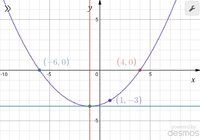You are using an out of date browser. It may not display this or other websites correctly.
You should upgrade or use an alternative browser.
You should upgrade or use an alternative browser.
Quadratic Equations
- Thread starter sapphire
- Start date
lev888
Elite Member
- Joined
- Jan 16, 2018
- Messages
- 2,939
Read Before Posting
Welcome to FreeMathHelp.com! Please take the time to read the following before you make your first post. It will help you to get your math questions answered promptly and in the most helpful manner. Don't post a list of homework problems. Please start new threads for new exercises. Try to...
www.freemathhelp.com
HallsofIvy
Elite Member
- Joined
- Jan 27, 2012
- Messages
- 7,763
If a quadratic function has a zero at x= 4 then it has x- 4 as a factor. If it has a zero at x= -6 then it has x+ 6 as a factor. Since it is quadratic those are the only factors, involving x, that it has. It can have constant factor. What must that constant be so that when x= 1, y= -3?
jonah2.0
Full Member
- Joined
- Apr 29, 2014
- Messages
- 534
If a quadratic has roots [MATH]x=\alpha[/MATH] and [MATH]x=\beta[/MATH], then it's equation is:Determine the equation, in factored form, of the parabola with roots at 4 and -6 that also passes through the point (1, -3).
[MATH]y=a(x-\alpha)(x-\beta)[/MATH], for some constant '[MATH]a[/MATH]'
You know two roots; one can be [MATH]\alpha[/MATH], one [MATH]\beta[/MATH], so you can fill in most of the equation.
To find the final bit '[MATH]a[/MATH]', use the point you have: when [MATH]x=1, y=-3[/MATH].
More succinct!y=A(x-r1)(x-r2)

